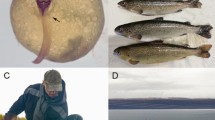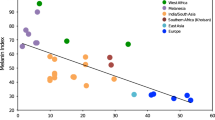Summary
Strains set up from single inseminated females of D. melanogaster derived from two wild populations have been shown to differ in their ability to withstand dessication, as measured by mortalities after 16 hours in a dry environment, thus there are genes segregating in wild populations for ability to withstand dessication. A more detailed study on strains from one of the wild populations, showed that strains with high wet and dry weights lose water by dessication relatively less rapidly and have lower mortalities, than strains with lower wet and dry weights.
Variability within and between five inbred strains was studied with results as above. Heritabilities for wet weight, dry weight, and mortality were 0.40, 0.41 and 0.60 respectively, showing the likelihood that the traits would be amenable to further genetic analysis.
The relevance of the results are discussed in relation to stress to high temperatures, and the ecology of the species in general.
Similar content being viewed by others
References
Dobzhansky, Th.: Genetics of natural populations. IX. Temporal changes in the composition of populations of Drosophila pseudoobscura. Genetics 28, 162 (1943).
Dobzhansky, Th.: Genetics and the Origin of Species (2nd ed.) New York: Columbia University Press 1951.
Hosgood, S. M. W., Parsons, P. A.: Polymorphism in natural populations of Drosophila for the ability to withstand temperature shocks. Experientia 24, 727–728 (1968).
Kalmus, H.: Adaptive and selective responses of a population of Drosophila melanogaster containing e and e+ to differences in temperature, humidity and selection for development speed. J. Genet. 47, 58 (1943).
Parsons, P. A.: A correlation between the ability to withstand high temperatures and radioresistance in Drosophila melanogaster. Experientia 25, 1000–1001 (1969).
Parsons, P. A., Hosgood, S. M. W.: Genetic heterogeneity among the founders of laboratory populations of Drosophila I. Scutellar chaetae. Genetica 38, 328–339 (1967).
Parsons, P. A., Hosgood, S. M. W., Lee, B.T. O.: Polygenes and polymorphism. Mol. Gen. Genet. 99, 165–176 (1967).
Parsons, P. A., MacBean, I. T., Lee, B. T. O.: Polymorphism in natural populations for genes controlling radioresistance in Drosophila. Genetics 61, 211- 218 (1969).
Pittendrigh, C. S.: Adaptation, natural selection, and behavior. In: Behavior and Evolution, ed. by A. Roe and G. G. Simpson, p. 390 bis 416. New Haven: Yale University Press 1958.
Thoday, J. M.: Location of polygenes. Nature 191, 368 (1961).
Waddington, C. H., Woolf, B., Perry, M. M.: Environment selection by Drosophila mutants. Evolution 8, 89–96 (1954).
Author information
Authors and Affiliations
Additional information
Communicated by G. Melchers
The competent technical assistance of Miss Clare Escott is gratefully acknowledged. Financial support from the Australian Institute of Nuclear Science and Engineering and the Australian Research Grants Committee, is gratefully acknowledged.
Rights and permissions
About this article
Cite this article
Parsons, P.A. Genetic heterogeneity in natural populations of Drosophila melanogaster for ability to withstand dessication. Theoret. Appl. Genetics 40, 261–266 (1970). https://doi.org/10.1007/BF00282036
Received:
Issue Date:
DOI: https://doi.org/10.1007/BF00282036




